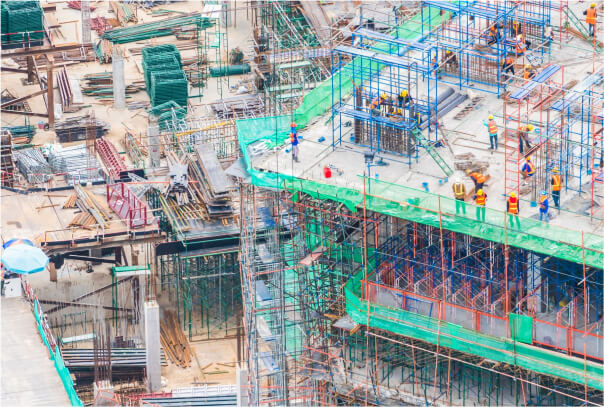India is upgrading. This super-mega-plan to modernise the country is part of a compelling narrative of economic transformation that has greatly accelerated in the last decade.
One of the key drivers of this economic surge is the construction industry, whose remarkable expansion can be gauged from these impressive numbers:
- The industry’s current market size is USD 639 billion, with a projected Compound Annual Growth Rate of 6% during the forecast period.
- It is the fourth-largest construction market in the world, after the US, China and Japan.
- It is the fastest-growing construction industry, globally. With an impressive 7-8% growth rate annually, India is expected to become the third-largest construction market in the world, valued at USD 1.4 trillion by 2025.
- It accounts for 9% of India’s GDP.
The extraordinary growth in the construction industry is largely due to the government’s special focus on infrastructure development. This includes mega-projects in sectors such as urban infrastructure, transportation, roads, irrigation and real estate.
that growth in infrastructure has on employment, the Union Budget for 2023-24 raised the capital outlay for this sector by 33%, for the third year in a row, to Rs 10 lakh crore. This constitutes 3.3% of the country’s GDP.
In addition, the Budget announced the setting up of the Urban Infrastructure Development Fund (UIDF), allocating Rs 10,000 crore per year to public agencies, to create urban infrastructure in Tier 2 and Tier 3 cities.
Ambitious programmes like these are generating considerable demand for quality construction materials such as cement, steel reinforcement bars, all kinds of hardware, power control solutions, and paints and coatings, among other things. The Building Materials Division of several companies in India, including Sicagen, have been working hard to keep up with this escalating demand.

Key projects driving growth
Transportation
Transportation infrastructure in India is getting a major upgrade. To improve connectivity, enhance trade, and simply make travel easier, the government is implementing the Sagarmala Program and the Bharatmala Pariyojana, to enhance port and highway systems across the country.
The Sagarmala Program will invest USD 10.5 million in over 610 projects between 2015 and 2035, upgrading ports, promoting port-based industrialisation, and developing coastal communities. The Bharatmala Pariyojana focuses on highway development, building economic corridors, feeder routes and greenfield expressways. The blueprint includes India’s largest expressway, a 1,386-km-long super-highway between Delhi and Mumbai.
The Airports Authority of India is investing INR 61,000 crore in building new airports, expanding and upgrading existing ones, and strengthening runways, technical blocks and control towers. It will also expand the three PPP airports, in Delhi, Bengaluru and Hyderabad, with an investment of INR 30,000 crore by 2025.
Urban infrastructure
Two mega-infrastructure development projects that are fuelling the exponential growth in the construction industry are the government’s Smart Cities Mission and the Atal Mission for Rejuvenation and Urban Transformation (AMRUT). While the first focuses on developing parts of cities as model areas so that this development can spread, the second programme aims to develop basic infrastructure in selected cities and towns, in the areas of water supply, sewerage, storm water drainage and green spaces.
Affordable housing
Robust economic growth has placed home ownership within the reach of the burgeoning middle and lower-income segments. At the forefront are government schemes for affordable housing such as the Pradhan Mantri Awas Yojana (PMAY), or Hosing For All scheme, which offers financial assistance to beneficiaries and incentives to builders. In the Budget for 2023-24, the outlay of the PMAY was increased by 66%, to over Rs 79,000 crore.
Moreover, by 2030, more than 40% of the population in India is projected to live in urban India, which will create a demand for 25 million additional affordable units, further boosting the construction industry.
Trends in the construction industry
Green building materials
Driven by concerns about the environment, there is a growing focus on using green building materials and sustainable construction practices. An India that is fast upgrading will also need energy-efficient power; and lighting, ventilation and air-conditioning systems. Companies specialising in green building materials and energy systems will benefit greatly from this trend.
Technology

The increasing use of technology is another trend shaping the construction industry in India. Many construction firms are adopting new technologies, such as Building Information Modeling (BIM), 3D printing and prefabricated technology, to enhance the efficiency and quality of their work. These technologies reduce costs and improve the speed of construction projects.
The availability of quality building materials is a crucial factor in the growth of India’s construction industry. Tamil Nadu is home to various companies that specialise in producing construction materials, including cement and steel suppliers, pipe and fittings suppliers, and paint and coatings manufacturers. Roofing material manufacturers in Chennai and flooring solutions providers in other parts of South India are also playing a significant role in the expansion of the construction industry in India. Kerala too is a key state supplying steel reinforcement bars and plumbing materials for construction projects.
India’s construction industry, the second-largest employer in the country, is expected to maintain its upward trajectory for several years. The market is very competitive due to the presence of major local and international players, but consolidation is unlikely. Developers who are tech-savvy, future-focused and commit to sustainability will be leading the charge into a future full of promise for this sector.


